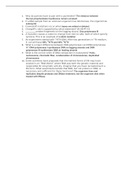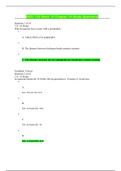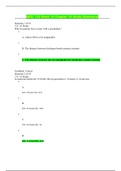BIOL 133 Week 14 Chapter 14 Study Questions (BIOL 133)
American Public University
All 3 results
Sort by

-
BIOL 133 Week 14 Chapter 14 Study Questions
- Exam (elaborations) • 1 pages • 2021
-
 joshgwam
joshgwam
-
- $10.49
- + learn more
BIOL 133 Week 14 Chapter 14 Study Questions If a DNA sample from an unknown organism has telomerase, the organism Why do purines have to pair with a pyrimidine? ________ creates fragments on the lagging strand. Chargaff’s rule is supported by what statement? What is the correct order of DNA compaction in eukaryotes?

-
BIOL 133 WEEK 10 CHAPTER 14 – QUESTION AND ANSWERS
- Exam (elaborations) • 6 pages • 2021
-
 NURSEREP
NURSEREP
-
- $7.49
- + learn more
BIOL 133 Week 14 Chapter 14 Study Questions If a DNA sample from an unknown organism has telomerase, the organism Why do purines have to pair with a pyrimidine? ________ creates fragments on the lagging strand. Chargaff’s rule is supported by what statement? What is the correct order of DNA compaction in eukaryotes? A mutation causes a codon to change from UAC to UAU, both of which specify tyrosine. This is an example of Some scientists have proposed that the earliest forms of life ma...

-
BIOL 133 WEEK 10 CHAPTER 14 – QUESTION AND ANSWERS
- Exam (elaborations) • 6 pages • 2021
-
 instructor
instructor
-
- $7.49
- + learn more
BIOL 133 Week 14 Chapter 14 Study Questions If a DNA sample from an unknown organism has telomerase, the organism Why do purines have to pair with a pyrimidine? ________ creates fragments on the lagging strand. Chargaff’s rule is supported by what statement? What is the correct order of DNA compaction in eukaryotes? A mutation causes a codon to change from UAC to UAU, both of which specify tyrosine. This is an example of Some scientists have proposed that the earliest forms of life ma...

How did he do that? By selling his study resources on Stuvia. Try it yourself! Discover all about earning on Stuvia


